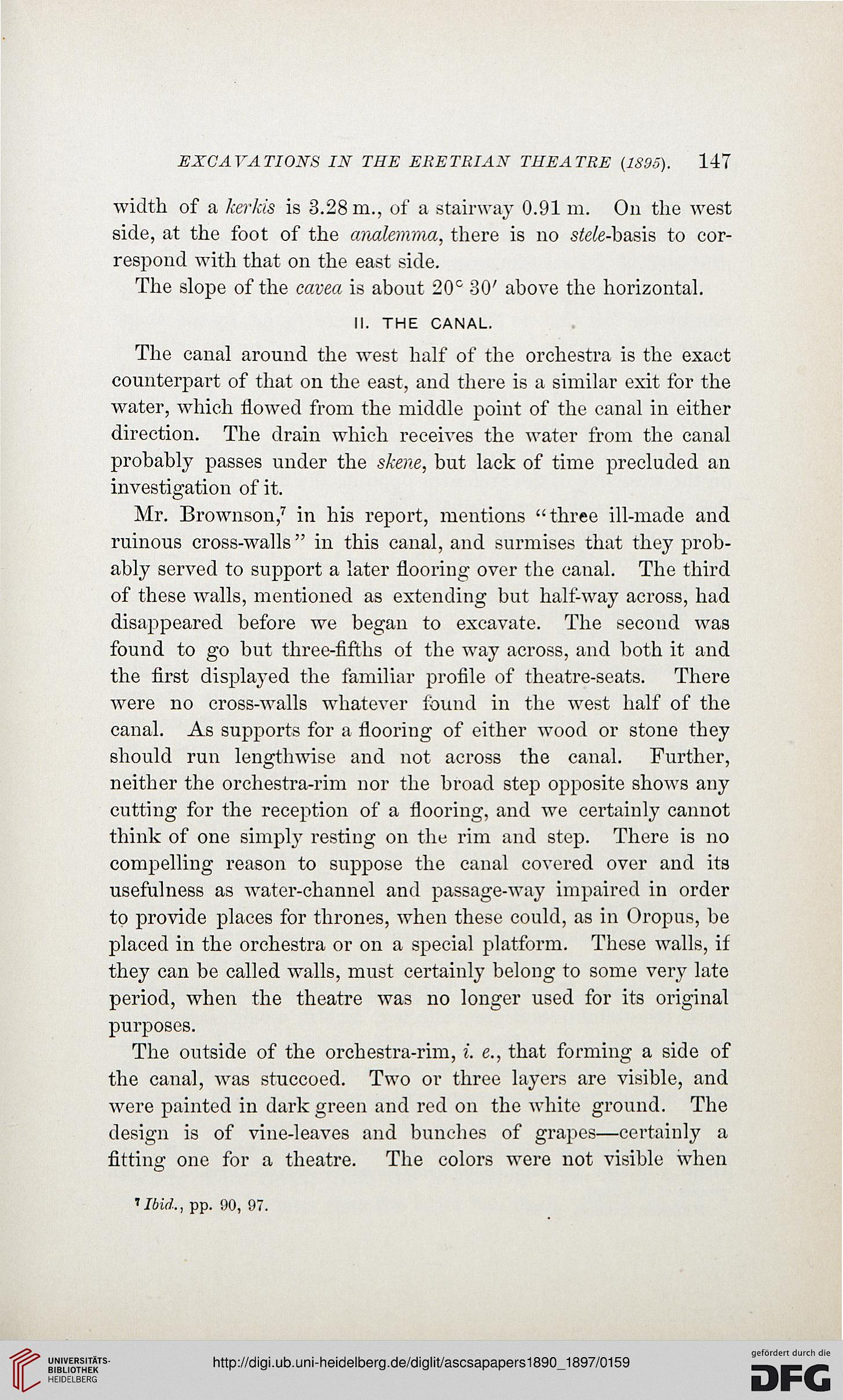EXCAVATIONS IN THE ERETRIAN THEATRE (1895).
147
width of a kerkis is 3.28 m., of a stairway 0.91 m. On the west
side, at the foot of the analemma, there is no sfcfe-basis to cor-
respond with that on the east side.
The slope of the cavea is about 20° 30' above the horizontal.
II. THE CANAL.
The canal around the west half of the orchestra is the exact
counterpart of that on the east, and there is a similar exit for the
water, which flowed from the middle point of the canal in either
direction. The drain which receives the water from the canal
probably passes under the skene, but lack of time precluded an
investigation of it.
Mr. Brownson,7 in his report, mentions "three ill-made and
ruinous cross-walls" in this canal, and surmises that they prob-
ably served to support a later flooring over the canal. The third
of these walls, mentioned as extending but halt-way across, had
disappeared before we began to excavate. The second was
found to go but three-fifths ot the way across, and both it and
the first displayed the familiar profile of theatre-seats. There
were no cross-walls whatever found in the west half of the
canal. As supports for a flooring of either wood or stone they
should run lengthwise and not across the canal. Further,
neither the orchestra-rim nor the broad step opposite shows any
cutting for the reception of a flooring, and we certainly cannot
think of one simply resting on the rim and step. There is no
compelling reason to suppose the canal covered over and its
usefulness as water-channel and passage-way impaired in order
to provide places for thrones, when these could, as in Oropus, be
placed in the orchestra or on a special platform. These walls, if
they can be called walls, must certainly belong to some very late
period, when the theatre was no longer used for its original
purposes.
The outside of the orchestra-rim, i. e., that forming a side of
the canal, was stuccoed. Two or three layers are visible, and
were painted in dark green and red on the white ground. The
design is of vine-leaves and bunches of grapes—certainly a
fitting one for a theatre. The colors were not visible when
Ubid., pp. 90, 07.
147
width of a kerkis is 3.28 m., of a stairway 0.91 m. On the west
side, at the foot of the analemma, there is no sfcfe-basis to cor-
respond with that on the east side.
The slope of the cavea is about 20° 30' above the horizontal.
II. THE CANAL.
The canal around the west half of the orchestra is the exact
counterpart of that on the east, and there is a similar exit for the
water, which flowed from the middle point of the canal in either
direction. The drain which receives the water from the canal
probably passes under the skene, but lack of time precluded an
investigation of it.
Mr. Brownson,7 in his report, mentions "three ill-made and
ruinous cross-walls" in this canal, and surmises that they prob-
ably served to support a later flooring over the canal. The third
of these walls, mentioned as extending but halt-way across, had
disappeared before we began to excavate. The second was
found to go but three-fifths ot the way across, and both it and
the first displayed the familiar profile of theatre-seats. There
were no cross-walls whatever found in the west half of the
canal. As supports for a flooring of either wood or stone they
should run lengthwise and not across the canal. Further,
neither the orchestra-rim nor the broad step opposite shows any
cutting for the reception of a flooring, and we certainly cannot
think of one simply resting on the rim and step. There is no
compelling reason to suppose the canal covered over and its
usefulness as water-channel and passage-way impaired in order
to provide places for thrones, when these could, as in Oropus, be
placed in the orchestra or on a special platform. These walls, if
they can be called walls, must certainly belong to some very late
period, when the theatre was no longer used for its original
purposes.
The outside of the orchestra-rim, i. e., that forming a side of
the canal, was stuccoed. Two or three layers are visible, and
were painted in dark green and red on the white ground. The
design is of vine-leaves and bunches of grapes—certainly a
fitting one for a theatre. The colors were not visible when
Ubid., pp. 90, 07.




